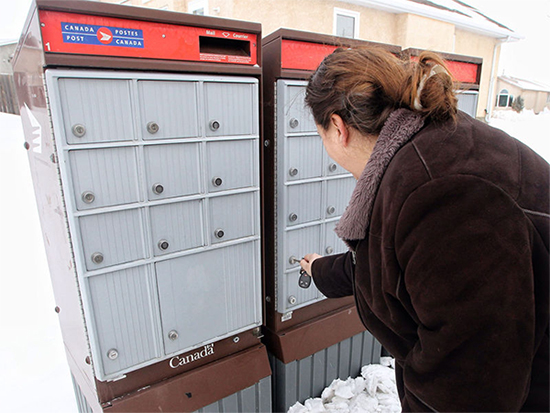By Brent Bellamy, Creative Director and Architect

Nixing door-to-door delivery in cities creates an opportunity to design unique community spaces that bring people together. It’s up to Canada Post to deliver. (MIKE DEAL / FREE PRESS FILES)
Canada is a nation of 35 million people, with 19 million Facebook users and four million Twitter accounts. In 2013, Canadians for the first time sent more than 100 billion text messages. Globally, more than two million emails are sent every second of every day.
Technology has fundamentally changed how we communicate, how we pay our bills, how we shop, play and do business. The effect of this evolution on the traditional mail service recently became clear with a Canada Post announcement of sweeping restructuring plans that include the controversial replacement of urban door-to-door delivery with community superboxes, commonly found in suburban subdivisions and rural municipalities.
In Canada's higher-density residential neighbourhoods, the ubiquitous presence of these new, externally located community mailboxes may significantly alter the image and physical character of inner-city areas across the country. In Winnipeg, as an example, the traditional tree-lined, grid-street neighbourhoods that define much of the city have as many as 50 detached homes on each block. Implementing the current Canada Post design would result in a box the length and height of a Ford Focus parked on the boulevard on every block on every street in these neighbourhoods. This pervasive visual presence would be significantly heightened in areas such as Osborne Village and the very high-density neighbourhoods of Canada's larger urban centres.
Execution of this strategy will be a monumental challenge. This unparalleled intervention into the landscape of every city across Canada does, however, represent a unique opportunity to strengthen the urban character of the nation's neighbourhoods in a single well-executed move. It's an opportunity -- through good design -- to promote urban vibrancy, neighbourhood walkability, public health and social interaction.
Attractive and dynamic cities value the quality of the human-scale elements we interact with every day. The fine-grained texture of paving patterns, light standards, boulevard trees, benches, parks, community gardens, corner stores and recreation centres all work together to establish neighbourhood character and create active, safe and cohesive communities.
Canada Post's new superbox plan might be seen as the development of new public spaces that weave themselves into this neighbourhood texture as small-scale nodes that encourage social connection by bringing people together in a role not unlike a modern expression of the traditional small town post office.
If allowed to dream, the opportunities for Canada Post are limitless. It might inspire goodwill and public support by engaging local creative communities through a well-publicized national design competition or a series of workshops.
Groups might brainstorm ideas, highlight local design opportunities and identify social, physical and climatic challenges. Designers might even be given a pre-fabricated kit of parts, set in a practical framework that would allow the creation of unique, cost-effective compositions with regional variation and local expression of creativity. These kiosks might be Wi-Fi hotspots that include space for lighting, poster boards, advertising opportunities, newspaper boxes, benches, small canopies and recycling containers.
Imagine the effect on local communities if the project is approached as the world's largest installation of functional public art, a series of beautifully designed objects salted through the landscape of every Canadian city, with a micro-plaza and engaging urban sculpture dispensing mail on every corner. On commercial sidewalks, small seating areas might be incorporated near shops to encourage pedestrian traffic to support local businesses. With a creative and holistic vision that reaches beyond mail delivery, the new superboxes might translate into a positive contribution to modern community life.
Of course, this is a very big dream in our 'every dollar counts' modern world. Whatever the likely 'one size fits most' solution will be, it is important it reaches beyond the traditional tin box bolted to the sidewalk model and is something that is well-designed, well-integrated and appealing to all communities, urban, suburban and rural. Our cities are a reflection of who we are. As Canadians we should demand creative thinking and quality design in our shared public space. Critical design challenges that must be addressed include accessibility for people with visual impairment and mobility issues, security from vandalism and theft, weather protection, personal safety, lighting, litter control, interaction with vehicular and pedestrian traffic patterns and as a prominent new component in the urban landscape, timeless visual appeal.
Canada Post's move to community superboxes in urban areas puts our cities at a crossroads. We are presented with a valuable opportunity to bravely meet this change with a forward-thinking response that translates a difficult challenge into a lasting positive investment in our communities. As the first G8 country to eliminate door-to-door mail delivery, the world will be watching.
By thinking progressively and committing to a vision of design quality, place-making and community building, this vast new web of miniature public spaces to be injected into the framework of all Canadian cities might add new energy to the social and physical networks of our neighbourhoods, establishing Canada as an urban design leader with a visionary model for the rest of the world to follow.
Brent Bellamy is senior design architect for Number Ten Architectural Group.
bbellamy@numberten.com
Republished from the Winnipeg Free Press print edition January 6, 2014 B4